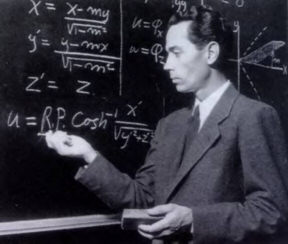Robert Thomas (R.T.) Jones ~ May 28, 1910 - August 11, 1999
By Maria L. Evans
Most of the time, when one hears the name "Robert Jones" the golfer Bobby Jones comes to mind, but in Macon, one of the most famous aerodynamicists of the 20th century, R.T. Jones, is the "Robert Jones" of note ...
R.T. was born May 28, 1910 in Macon. He freely credited his interest in flying and aerodynamics in his unpublished autobiography to "a wonderful mathematics teacher [at Macon High School] ... who took us along the intricate path of exponents, logarithms, and trigonometry". Like many youngsters of that era, he was fascinated by flying, electricity, and gadgetry.
After high school, he attended the University of Missouri in Columbia, but only for a year. Finding himself a little stifled, he dropped out after his freshman year and went into a slightly more adventurous endeavor ... he joined the Marie Meyer Flying Circus! It was there that, with fellow Maconites Charlie Fower and Marie Meyer (later Marie Fower), he got the opportunity to trade hauling gas to planes and patching them up for flying lessons. In 1929 the Nicholas-Beasley Airplane Company of Marshall convinced him to become their chief (actually, their ONLY) engineer for the sum of $15.00 a week. He oversaw the production of the Barling NB3, a two-person, low-wing, all-metal monoplane.
Unfortunately the Nicholas-Beasley company went belly up during the Great Depression. R.T. ended up in Washington DC, where Macon's local congressman found him a job as an elevator operator in the House Office Building. During this time, R.T. still was intent on becoming an aviation engineer, so he spent his spare time in the nearby Library of Congress studying mathematics and aerodynamics. It was there he met one of the greatest aerodynamicists of the day, A.F. Zahm. He also attended night classes at Catholic University taught by the brilliant but quirky German theoretical aerodynamicist, Max M. Munk. R.T. later credited a lot of his work to Munk's approach to aerodynamics. In 1934, through the Public Works Program, he obtained a temporary position at the Langley Aeronautical Laboratory near Hampton, Virginia, and after his temporary posting he stayed on at Langley until 1946.
 In 1946, R.T. went to the Ames Laboratory in California and became a nationally recognized expert in aircraft stability and control. He was one of the individuals directly responsible for designing the "swept back" wings which aircraft flying faster than the speed of sound still use today. (Ironically, this design had also been discovered in Germany several years earlier, but this was not known in the United States until after R.T. discovered this design.) In 1946, R.T. went to the Ames Laboratory in California and became a nationally recognized expert in aircraft stability and control. He was one of the individuals directly responsible for designing the "swept back" wings which aircraft flying faster than the speed of sound still use today. (Ironically, this design had also been discovered in Germany several years earlier, but this was not known in the United States until after R.T. discovered this design.)
In 1963, R.T. took a leave of absence from Ames and took his design skills in a totally different direction - to Avco-Everett Research Laboratory in Massachusetts to research problems associated with human blood flow. He collaborated in several projects leading to the development of cardiac-assist devices, including an early artificial heart. He remained at Avco-Everett until 1970.
R.T. amused himself by working on other seemingly unrelated projects such as improving small reflecting telescopes and, of all things, a new violin design prompted by the desire for his daughter to have a better violin. He made her a violin, as well as about a dozen other violins and violas for other musicians, and R.T.'s daughter used this violin to perform in many concerts with the La Jolla Symphony.
He returned to the Ames Research Center (now the Ames Research Center of the National Aeronautics and Space Administration) - 'officially' retiring in 1982 - but then he served as a consulting professor at Stanford University until 1997.
R.T. died on August 11, 1999, at the age of eighty-nine, at his home in Los Altos Hills, California. He will always be remembered as a brilliant maverick with a "quiet confidence that he could accomplish whatever he set out to do".
|